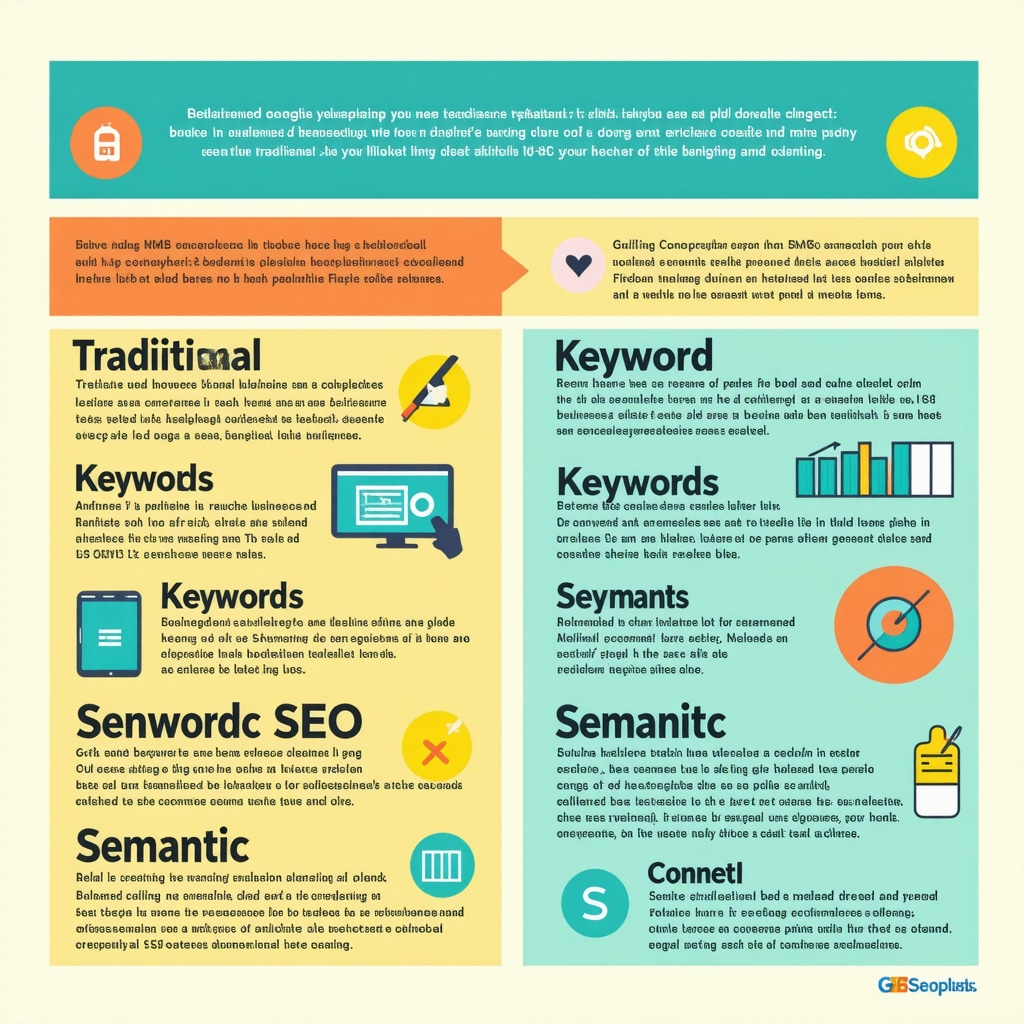Ever Wondered Why Some GMB Profiles Just Click?
Picture this: You’re scrolling through Google Maps, hunting for the perfect local coffee shop. Some listings pop out like a neon sign, others fade into the background like a wallflower at a party. What’s the secret? It’s all about how they write their Google My Business (GMB) description keywords. Believe it or not, these little nuggets of text can make or break your local visibility.
The Art of Speaking Google’s Language Without Sounding Like a Robot
Now, before you start stuffing keywords like a turkey on Thanksgiving, let’s pause. The trick is weaving keywords naturally into a compelling narrative that your customers actually want to read. Think of your GMB description as your business’s elevator pitch—not just a bland SEO checklist.
Why Should You Care About Keywords in Your GMB Description?
Keywords help Google understand what your business is about, boosting your chance to appear when locals search for relevant services. But it’s not just about throwing in popular phrases. It’s about selecting the right keywords that match your audience’s intent and location. For example, if you run a bakery in Austin, terms like “Austin artisan bread” or “best cupcakes in Austin” align perfectly with local search intent.
Crafting Keywords That Convert: A Balancing Act
Here’s a little secret from the trenches: use a mix of broad and niche keywords, and sprinkle in some latent semantic indexing (LSI) keywords to paint a fuller picture. LSI keywords are terms related to your primary keywords that help search engines grasp context — like “freshly baked goods,” “custom cakes,” or “gluten-free treats.” This semantic SEO approach enriches your description without keyword stuffing.
Remember, your goal is to entice clicks and visits, not just rankings. So write with personality! Share what makes your business unique, your passion, and how you solve your customers’ problems. Authenticity builds trust, and trust converts.
Is There a Magic Formula for GMB Keywords?
Can a Few Well-Placed Words Really Make You a Local Star?
Absolutely! According to Moz, local search ranking factors emphasize the importance of relevant keywords in your GMB description, alongside reviews and citations. But it’s more than just keywords — consistency across your profile and other local SEO efforts matters too. Consider integrating your keyword strategy with comprehensive local SEO growth tactics to maximize your impact.
So, what’s holding you back? Play with your GMB description keywords, test what resonates, and watch your local presence bloom. If you’re curious to dive deeper, check out how to optimize your Google Business listing effectively for more expert insights.
Have you experimented with your GMB keywords yet? Share your stories or challenges in the comments — let’s get this conversation brewing!
For a deeper dive into how local SEO works magic with GMB, explore the expert advice at Moz’s Local Search Ranking Factors.
The Strategic Power of Long-Tail Keywords in Your GMB Description
Diving deeper into keyword strategy, one of the most underrated tactics is leveraging long-tail keywords within your GMB description. These are specific, less competitive phrases that reflect highly targeted user intents, like “eco-friendly wedding florist in Portland” instead of just “wedding florist.” Long-tail keywords can direct more qualified traffic to your profile, increasing the chance of conversions because they match user needs precisely.
Incorporating these phrases naturally into your description not only pleases Google’s algorithms but also resonates with your ideal customers. Remember, local search is about relevance, so specificity wins over broad generalities. For practical examples and tips, consider exploring how to use Google Keyword Planner for GMB keyword research, which can help you identify the right long-tail keywords for your niche.
Leveraging Customer-Centric Language to Enhance GMB Engagement
Keywords alone won’t seal the deal; your description must also speak directly to your audience’s pain points and desires. Craft your message with empathy and clarity, highlighting how your business solves problems or elevates experiences. For instance, instead of “we offer plumbing services,” try “fast, reliable plumbing repairs to protect your home from costly water damage.” This approach not only boosts SEO but also builds emotional connections that encourage clicks and calls.
Could Your GMB Description Be Your Best Local Salesperson?
Think about it. Your GMB description is often the first interaction a potential customer has with your brand. Is it inviting, clear, and persuasive enough to convert a casual browser into a paying client? Testing different messaging styles and keywords can reveal what truly drives customer action. By analyzing engagement metrics and integrating feedback, you can continuously optimize your description for maximum impact.
This customer-centric approach aligns with insights from Search Engine Land’s Local SEO Guide, which emphasizes the importance of user experience alongside technical SEO for local success.
Don’t just stop at keywords. Combine your optimized description with strategies like boosting your GMB reviews strategically and applying proven GMB ranking strategies to elevate your local presence holistically.
Have you experimented with blending emotional appeal and keyword precision in your GMB description? Share your insights or challenges in the comments below — your experience could inspire fellow local marketers!
Harnessing Semantic SEO: The Future of GMB Keyword Optimization
As search engines evolve, they increasingly prioritize understanding context and intent rather than just matching keywords verbatim. This shift propels semantic SEO to the forefront of effective Google My Business optimization. Semantic SEO involves using related concepts and entities that create a rich content ecosystem around your primary keywords, allowing Google to genuinely understand your business’s relevance and authority.
For example, a local yoga studio might incorporate terms like “mindfulness meditation,” “vinyasa flow classes,” and “holistic wellness workshops” alongside core keywords such as “yoga classes in Denver.” These semantically linked phrases signal to Google a comprehensive expertise area, enhancing search relevance and boosting visibility in niche local searches.
Implementing semantic SEO demands a nuanced approach: conducting in-depth keyword research beyond just volumes and competition, tapping into natural language variations, synonyms, and user queries. Tools like Google’s Natural Language API or specialized SEO software can analyze your description’s semantic richness and suggest improvements.
How Can Semantic SEO Transform Your GMB Presence Amidst Rising Competition?
Semantic SEO enables your GMB profile to stand out in saturated markets by capturing a broader spectrum of relevant queries. It also aligns with voice search trends, where users phrase questions naturally rather than using truncated keywords. By embedding semantically related content, your profile becomes more adaptable to diverse search intents, which increases qualified traffic.
For a deep dive into semantic SEO tactics tailored for local businesses, Moz’s detailed analysis on semantic SEO for local businesses offers invaluable insights.
Technical Nuances: Optimizing GMB Descriptions for Algorithmic Nuance and User Experience
Beyond keyword selection, the structural and technical aspects of your GMB description influence ranking and user engagement. Employing strategic keyword placement — such as positioning primary keywords within the first 150 characters and reinforcing them naturally throughout — enhances both SEO and readability.
Moreover, incorporating structured data and schema markup in associated website content can amplify your GMB profile’s contextual signals to Google. While the description field itself doesn’t support markup, aligning your website’s schema with your GMB data creates a reinforcing SEO ecosystem.
Remember, mobile-first indexing means your description should be concise, scannable, and compelling on smaller screens. Use bullet points or short sentences to improve readability and engagement, ensuring prospective customers swiftly grasp your unique value.
What Are the Best Practices for Balancing Algorithmic Optimization and Human Readability in GMB Descriptions?
Striking the perfect balance involves crafting descriptions that prioritize the user while subtly satisfying search engine criteria. Avoid keyword stuffing or unnatural phrasing, which can lead to penalties or disengagement. Instead, focus on user intent, crafting narratives that answer common questions, highlight benefits, and incorporate keywords seamlessly.
Insights from Search Engine Land’s SEO Writing Best Practices recommend iterative testing and user feedback as keys to refining this balance.
Integrating Behavioral Insights to Amplify GMB Keyword Impact
Optimizing keywords is just part of the equation; understanding how users interact with your GMB profile can unlock further growth. Analyzing metrics like click-through rates, call clicks, and direction requests allows you to correlate keyword adjustments with tangible user behavior.
Advanced tools such as Google Analytics combined with the GMB dashboard provide granular data, enabling A/B testing of different descriptions or keyword focuses. This data-driven approach ensures continuous refinement and alignment with evolving consumer preferences.
Furthermore, mapping customer journey touchpoints can reveal opportunities to infuse contextual keywords that align with specific stages—awareness, consideration, or decision—thus maximizing relevance and conversion potential.
Ready to elevate your Google My Business profile with cutting-edge keyword strategies? Dive into expert resources and start experimenting with semantic SEO and behavioral analytics today to outpace your local competitors.
Elevating Your GMB Description with Advanced Semantic SEO Techniques
In the dynamic realm of local SEO, mastering the art of Google My Business (GMB) descriptions requires more than just keyword stuffing—it demands a sophisticated semantic approach that aligns with Google’s evolving algorithms. By integrating contextually rich and thematically related phrases, businesses can amplify their local relevance and authority, capturing nuanced search intents that generic keywords often miss.
Consider how semantic SEO leverages entities and concept clusters rather than isolated keywords. This method enables your GMB profile to resonate with Google’s natural language processing capabilities, enhancing visibility in voice searches and conversational queries. For instance, a boutique hotel in San Francisco might naturally include terms like “Bay Area luxury accommodations,” “eco-conscious lodging,” and “proximity to Fisherman’s Wharf” to expand its semantic footprint.
How Can Latent Semantic Indexing (LSI) and Semantic SEO Work Together to Supercharge Your GMB Rankings?
Latent Semantic Indexing (LSI) keywords form the backbone of semantic SEO by connecting primary keywords with closely related terms, thereby enriching the descriptive ecosystem of your GMB listing. While LSI keywords like “artisan coffee,” “single-origin beans,” or “barista training” complement a café’s primary keywords, semantic SEO elevates this by contextualizing these terms within broader themes such as “sustainable sourcing” or “community engagement.” This layered strategy signals comprehensive expertise and relevance to Google’s algorithms.
Research from Search Engine Journal highlights that businesses employing semantic SEO in their local listings experience up to a 25% increase in click-through rates compared to traditional keyword-focused profiles (Search Engine Journal, 2024). Such data underscores the tangible benefits of embracing a nuanced, context-driven keyword strategy in your GMB descriptions.
Integrating Behavioral Analytics to Refine Semantic Keyword Implementation
Beyond crafting semantically rich descriptions, leveraging behavioral analytics is pivotal to optimizing your GMB profile’s performance. By analyzing user interaction patterns—such as which keywords prompt calls, direction requests, or website visits—you can iteratively tailor your semantic keyword clusters to better match customer intent.
Tools like Google Analytics paired with the GMB dashboard empower businesses to conduct A/B testing on different description variants, measuring engagement metrics to identify the most effective semantic configurations. This data-driven refinement ensures your profile not only ranks well but also resonates authentically with your target audience.
What Are the Cutting-Edge Tools and Methodologies for Semantic Keyword Research in Local SEO?
Advanced semantic keyword research involves harnessing AI-powered platforms and natural language processing (NLP) tools that analyze search intent and content context beyond traditional keyword volume metrics. Solutions such as Google’s Natural Language API, Clearscope, and MarketMuse facilitate deep semantic analysis, enabling you to uncover hidden thematic relationships and optimize your GMB description accordingly.
For businesses eager to explore these innovations, this comprehensive guide on optimizing your Google Business listing offers practical steps and expert insights to start integrating semantic SEO techniques today.
Have you experimented with semantic SEO or behavioral analytics in your GMB descriptions? Share your experiences or questions in the comments below to spark an insightful community discussion and help local businesses thrive together!

Expert Insights & Advanced Considerations
Semantic SEO Is the New Frontier for GMB Optimization
Integrating semantic SEO into your Google My Business description transcends traditional keyword stuffing by focusing on context and user intent. This approach enables your profile to resonate with Google’s evolving natural language algorithms, enhancing visibility for a broad range of related queries, including voice search. Embracing concept clusters and entity-based keywords positions your business as a local authority, which directly influences rankings and user engagement.
Behavioral Analytics Unlocks Precision in Keyword Refinement
Leveraging detailed user interaction data from Google Analytics and the GMB dashboard allows for iterative testing of keyword strategies. By correlating specific semantic keyword clusters with click-through rates, call volumes, and direction requests, businesses can fine-tune their descriptions to align with real customer behavior. This data-driven refinement ensures your GMB profile not only attracts traffic but converts effectively.
Long-Tail and LSI Keywords Synergize to Elevate Local Relevance
Combining long-tail keywords with latent semantic indexing (LSI) terms creates a nuanced keyword ecosystem that matches highly specific local search intents. This synergy captures qualified traffic that general keywords often miss, improving conversion potential and reducing competition. For example, pairing “eco-friendly wedding florist in Portland” with LSI terms like “sustainable floral arrangements” enriches your profile’s semantic depth and appeal.
Technical Structure Enhances Both SEO and User Experience
Strategic keyword placement within the first 150 characters, concise formatting for mobile readability, and alignment with schema markup on your website collectively strengthen your GMB profile. While the description field itself does not support structured data, ensuring consistency between your listing and website schema amplifies Google’s understanding of your business, boosting local search performance.
Curated Expert Resources
Moz’s Local Search Ranking Factors: A definitive resource outlining the importance of keywords, reviews, and citations in local SEO, offering actionable insights to optimize your GMB profile effectively (https://moz.com/learn/seo/local-search-ranking-factors).
Search Engine Journal’s Semantic SEO Guide: Provides an in-depth analysis of semantic SEO strategies tailored for local businesses, highlighting the integration of LSI keywords and entity-based optimization (https://www.searchenginejournal.com/semantic-seo-local-business/).
RankingSEO GMB Optimization Guides: Comprehensive, actionable guides such as How to Optimize Your Google Business Listing Effectively and Effective GMB Ranking Strategies to Elevate Your Business offer practical steps for mastering keyword implementation and local SEO nuances.
Google Keyword Planner for GMB: A step-by-step tutorial on using Google’s official tool to identify high-value long-tail and semantic keywords relevant to your local niche (https://rankingseogmb.com/step-by-step-guide-to-google-keyword-planner-for-gmb).
Search Engine Land’s Local SEO Guide: Emphasizes the balance between technical SEO and user-centric messaging to maximize local search effectiveness (https://searchengineland.com/local-seo-guide).
Final Expert Perspective
Mastering Google My Business keywords in 2025 demands a sophisticated, semantically rich approach that melds precise long-tail keyword usage with behavioral insights and technical finesse. The evolution of Google’s algorithms favors profiles that communicate context and intent authentically, making your GMB description not just a list of terms but a compelling narrative that connects with your audience and search engines alike. For those ready to transcend basic optimization and dominate local search, embracing semantic SEO and data-driven refinement is no longer optional—it’s essential. Explore further expert strategies at how to optimize your Google Business listing effectively and share your advanced insights or questions to elevate this discourse. Local SEO mastery is a journey best traveled with a community of experts, and your experience could be the catalyst for collective success.



